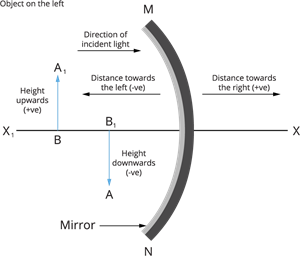
PUMPA - SMART LEARNING
எங்கள் ஆசிரியர்களுடன் 1-ஆன்-1 ஆலோசனை நேரத்தைப் பெறுங்கள். டாப்பர் ஆவதற்கு நாங்கள் பயிற்சி அளிப்போம்
Book Free DemoWe will use a set of sign conventions called the New Cartesian Sign Convention when dealing with a light reflection by spherical mirrors. The mirror's pole (P) is used as the origin in this convention. The x-axis (X'X) of the coordinate system is taken as the principal axis of the mirror.
The following are the rules to be followed while using sign convention:
- Always place the object to the left of the mirror. This indicates that the object's light strikes the mirror from the left side.
- The mirror's pole is used to measure all distances parallel to the principal axis.
- All distances to the right of the origin (along + x-axis) are positive, while those to the left (along – x-axis) are negative.
- Positive distances are measured perpendicular to and above the principal axis (along + y-axis).
- Negative values are assigned to distances measured perpendicular to and below the principal axis (along the –y-axis).

Sign convention for spherical mirrors
The below table shows the sign convention,
